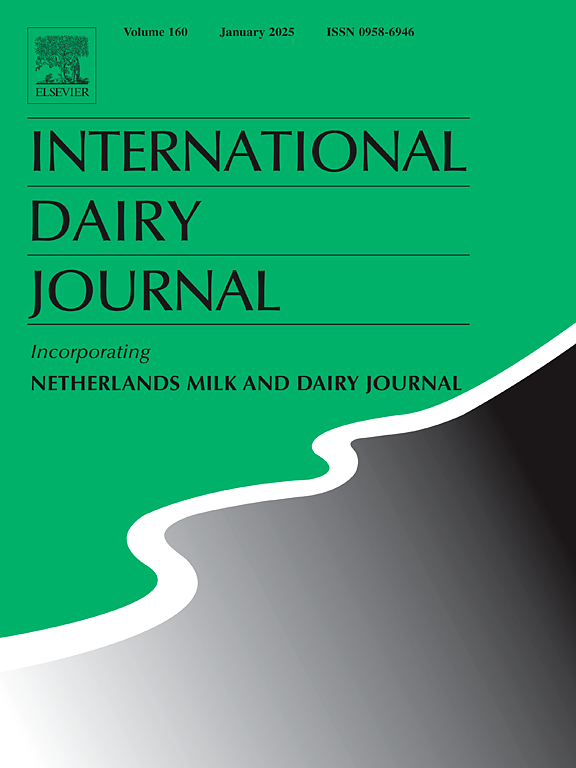加热过程中牛奶pH值对热致和酸致牛奶凝胶的凝胶化和结构特性的影响
IF 3.4
3区 农林科学
Q2 FOOD SCIENCE & TECHNOLOGY
引用次数: 0
摘要
乳清蛋白在牛奶热处理过程中的聚集及其与酪蛋白胶束的相互作用受加热过程中牛奶pH值的影响。尽管所有凝胶都是在pH为5.2时形成的,但预计这些相互作用会影响酸凝胶和热诱导凝胶的结构性质。在本研究中,研究了pH值在6.1 ~ 6.9之间的牛奶预热对酸凝胶和热致凝胶的组成、结构和质地的影响。在较高pH值(6.7和6.9)下,牛奶的凝胶保持了更多的水分,钙含量更低,回收率更高,而在较低pH值(6.1和6.35)下,牛奶的凝胶具有更高的杨氏模量和硬度。相反,pH值为6.9的凝胶更有弹性、更脆、更有凝聚力,尽管它们的硬度较低。凝胶网络的形成主要受静电相互作用、氢桥和钙桥的控制。随着pH的增加,静电相互作用和氢键的增强伴随着显著的二级结构转变,其特征是α-螺旋和β-片含量减少,β-匝数增加,随机线圈水平稳定,导致蛋白质网络变弱。加热前的轻微pH值调整会深刻影响蛋白质聚集、网络组装和结构特性。本文章由计算机程序翻译,如有差异,请以英文原文为准。
Effect of milk pH during heating on gelation and textural properties of heat and acid-induced milk gels
The aggregation of whey proteins and their interaction with casein micelles during milk heat treatment is influenced by the pH of milk during heating. These interactions are expected to influnce the textural properties of acid and heat-induced gels, even though all gels are formed at pH of 5.2. In this study, the influence of pre-heating milk at pH between 6.1 and 6.9 on composition, structure and texture of acid and heat–induced gels was studied. Gels produced from milk at higher pH (6.7 and 6.9) retained more moisture, had lower calcium content, and yielded higher recovery, while gels produced from milk at lower pH (6.1 and 6.35) exhibited significantly higher Young's modulus and hardness. Conversely, gels at pH 6.9 were more springy, brittle, and cohesive despite their lower firmness. Gel network formation was mainly governed by electrostatic interactions, hydrogen bridges and calcium bridges. As pH increased, enhanced electrostatic interactions and hydrogen bonding were accompanied by notable secondary structural transitions marked by decreases in α-helix and β-sheet content, increases in β-turns, and stable random coil levels—resulting in weaker protein networks. Minor pH adjustments prior to heating can profoundly affect protein aggregation, network assembly, and textural properties.
求助全文
通过发布文献求助,成功后即可免费获取论文全文。
去求助
来源期刊

International Dairy Journal
工程技术-食品科技
CiteScore
6.50
自引率
9.70%
发文量
200
审稿时长
49 days
期刊介绍:
The International Dairy Journal publishes significant advancements in dairy science and technology in the form of research articles and critical reviews that are of relevance to the broader international dairy community. Within this scope, research on the science and technology of milk and dairy products and the nutritional and health aspects of dairy foods are included; the journal pays particular attention to applied research and its interface with the dairy industry.
The journal''s coverage includes the following, where directly applicable to dairy science and technology:
• Chemistry and physico-chemical properties of milk constituents
• Microbiology, food safety, enzymology, biotechnology
• Processing and engineering
• Emulsion science, food structure, and texture
• Raw material quality and effect on relevant products
• Flavour and off-flavour development
• Technological functionality and applications of dairy ingredients
• Sensory and consumer sciences
• Nutrition and substantiation of human health implications of milk components or dairy products
International Dairy Journal does not publish papers related to milk production, animal health and other aspects of on-farm milk production unless there is a clear relationship to dairy technology, human health or final product quality.
 求助内容:
求助内容: 应助结果提醒方式:
应助结果提醒方式:


